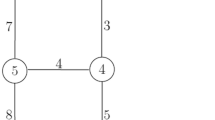Abstract
The design of new water distribution networks (WDNs) is an important social problem. Failures during an operational period provoke deficits in consumption nodes thus decreasing the performance of the network. WDN performance can be defined as the ability to sufficiently secure demand and desirable pressure in nodes based on changes in design parameters. This paper focuses on the evaluation of network performance during an operational period, taking into account pipe roughness uncertainty. A network analysis is performed by generating probabilistic series of pipe roughness using Monte Carlo simulation (MCS) in the operational period of the Two-loop WDN. Results show that an increase in pipe roughness uncertainty causes a decrease in network performance in the operational period. Furthermore, the network has a desirable efficiency only in the first 10 years. Thus, the proposed design methodology that considers the uncertainty of design variables is an effective procedure to evaluate network performance.









Similar content being viewed by others
References
Alperovits A, Shamir U (1977) Design of optimal water distribution systems. Water Resour Res 13(6):885–900
Bao Y, Mays LW (1990) Model for water distribution system reliability. J Hydraul Eng 116(9):1119–1137
Beygi S, Bozorg Haddad O, Fallah-Mehdipour E, and Mariño, MA (2013) “Bargaining models for optimal design of water distribution networks.” J Water Resour Plan Manag, In Press
Bozorg Haddad O, Adams BJ, Mariño MA (2008) “Optimum rehabilitation strategy of water distribution systems using the HBMO algorithm”. J Water Supply Res Technol AQUA 57(5):337–350
Eusuff MM, Lansey KE (2003) “Optimization of water distribution network design using the shuffled frog leaping algorithm”. J Water Resour Plan Manag ASCE 129(3):210–225
Fallah-Mehdipour E, Bozorg Haddad O, Beygi S, Mariño MA (2011) Effect of Utility Function Curvature of Young’s Bargaining Method on the Design of WDNs. Water Resour Manag 25(9):2197–2218
Ghajarnia N, Bozorg Haddad O, Mariño MA (2011) Performance of a novel hybrid algorithm in the design of water networks. Proc Inst Civ Eng Water Manag 164(4):173–191
Hudson WD (1966) “Studies of distribution system capacity in seven cities.” J Am Water Works Assoc, 157–164
Kapelan Z, Savic DA, Walters GA (2005) Multiobjective design of water distribution systems under uncertainty. Water Resour Res 41(11):11407–11415
Lansey KE, Duan N, Mays LW, Tung YK (1989) Water distribution system design under uncertainties. J Water Resour Plan Manag 115(5):630–645
Luong HT, Nagarur NN (2001) Optimal replacement policy for single pipes in water distribution networks. Water Resour Res 37(12):3285–3293
Murray R, Janke R, and Uber JG (2004) “The threat ensemble vulnerability assessment (TEVA) program for drinking water distribution system security.” Proceedings of World Water & Environmental Resources Congress, EWRI-ASCE, Reston, Va
Nikjoofar A, Zarghami M (2013) “Water Distribution Networks Designing by the Multiobjective Genetic Algorithm and Game Theory.” Meta-heuristics in Water, Geotechnical and Transport Engineering, 99–119
Propato M, Uber JG (2004) Vulnerability of water distribution systems to pathogen intrusion: How effective is a disinfectant residual? Environ Sci Tech 38(13):3713–3723
Sabbaghpour S, Naghashzadehgan M, Javaherdeh K, Bozorg Haddad O (2012) HBMO algorithm for calibrating water distribution network of Langarud city. Water Sci Technol 65(9):1564–1569
Seifollahi-Aghmiuni S, Bozorg Haddad O, Omid MH, Mariño MA (2011) Long-term analysis of water distribution network’s efficiency under demand uncertainty. Proc Inst Civ Eng Water Manag 164(3):147–159
Sharp WW, Walski TM (1988) Predicting internal roughness in water mains. J Am Water Works Assoc 80(11):34–40
Soltanjalili M, Bozorg-Haddad O, Mariño MA (2010) Effect of Breakage Level One in Design of Water Distribution Networks. Water Resour Manag 25(1):311–337
Soltanjalili M, Bozorg Haddad O, and Mariño MA (2013a) “Operating water distribution networks during water shortage conditions using hedging and intermittent water supply concepts.” J Water Resour PlanManag, In Press
Soltanjalili M, Bozorg Haddad O, Seifollahi-Aghmiuni S and Mariño MA (2013b) “Simulation of water distribution networks operation by optimization approaches.” Water Sci Technol Water Supply, In Press
Xu C, Goulter IC (1998) Probability model for water distribution reliability. J Water Resour Plan Manag 124(4):218–228
Xu C, Goulter IC (1999) Reliability based optimal design of water distribution networks. J Water Resour Plan Manag 125(6):352–362
Author information
Authors and Affiliations
Corresponding author
Rights and permissions
About this article
Cite this article
Seifollahi-Aghmiuni, S., Bozorg Haddad , O., Omid, M.H. et al. Effects of Pipe Roughness Uncertainty on Water Distribution Network Performance During its Operational Period. Water Resour Manage 27, 1581–1599 (2013). https://doi.org/10.1007/s11269-013-0259-6
Received:
Accepted:
Published:
Issue Date:
DOI: https://doi.org/10.1007/s11269-013-0259-6




